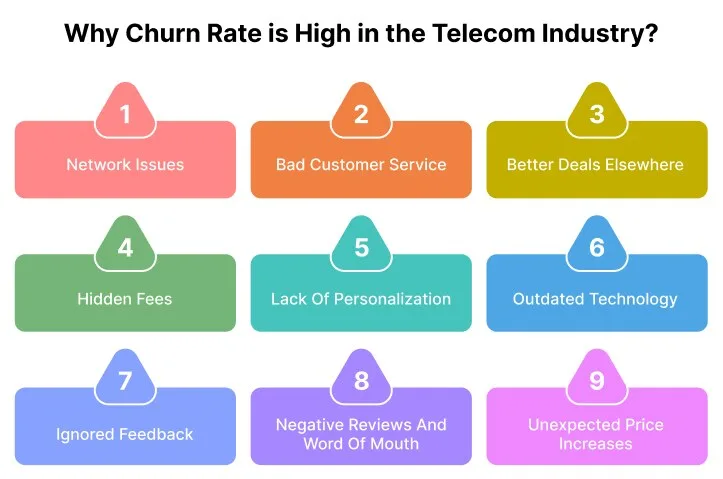Customer Retention in Telecom Industry: 6 Best Strategies
- February 15, 2024
- 14 mins read
- Listen

Let’s start with a report from Accenture. As per their research, 77% of consumers are shifting from one brand to another much faster than they did three years ago. This means that telecommunication companies (telcos) must put in extra effort to retain their customers.
For any business to do well, it needs customers. But it’s not just about attracting them initially; it’s also about keeping them around. While many businesses focus on gaining new customers, what really sets you apart is how well you can retain the ones you already have.
Getting new customers can be expensive, often costing five to seven times more than keeping existing ones. So, it’s crucial to work on strategies to hold onto your current customer base. Customer retention involves keeping customers happy and satisfied, which can be achieved through improved customer service and other tactics like loyalty programs or discounts for existing customers.
In the telecoms industry, retaining customers is a constant challenge. So, in this blog, we will uncover innovative strategies, navigate through the complexities of customer churn, and reveal the keys to building lasting customer relationships and retaining them for a longer span.
Current Scenario of the Telecom Industry
To ensure customer retention in the telecom industry, telecom companies are exploring fresh approaches to ensure their users stay satisfied, responding to increased competition and evolving customer expectations. Recent data indicates that globally, around 15% of telecom customers are switching to other services, posing a significant challenge for companies to retain them.
In the realm of mobile services, the situation is even more delicate, with a higher customer loss of about 20%. This is primarily due to people being particularly mindful of prices and features when it comes to mobile phones.
To address this issue, telecom companies are investing more in tools like customer analytics, providing personalized services, and being proactive in offering top-notch customer service. They’re also getting creative with strategies such as bundling services, launching loyalty programs, and using data to understand and cater to individual customer needs.
As the telecom landscape continues to evolve, maintaining customer satisfaction is very important for these companies to not only grow but also to ensure sustained success and profitability.
What Do Customers Want from the Telecom Industry?
Telecom customers seek reliable and affordable services with transparent billing, emphasizing a need for consistent and efficient customer support. fast and stable internet speeds, flexibility in plan options, and transparent communication regarding changes to services.
In short, most people consider a good customer experience important when choosing telecom services. Unfortunately, telecom companies are currently not doing well in meeting customer needs and are ranked low among different industries. If they don’t improve soon, they might not only lose money in the short term but also make customers even more unhappy.
Failure to provide a satisfactory customer experience inevitably results in customer loss. A recent study revealed that 39% of Americans who terminated a contract with a company in the last 24 months did so primarily due to inadequate customer service. Among those who canceled phone, internet, TV, or cable contracts (making up 52% in total), 64% terminated services after a prolonged negative experience, while only 17% did so following a one-time crisis.
Customers are willing to overlook occasional mistakes but will not tolerate consistently subpar experiences. As the world evolves, customers now have specific expectations from telecom brands regarding how they address their needs. They expect:
- Reliable service
- Affordable pricing
- Quality customer support
- Fast and stable internet speeds
- Flexibility in plans
- Innovative features and services
- Ease of switching and portability
- Security and privacy
Tackling the Rising Churn Rate in the Telecom Industry
Churn occurs when a customer discontinues using a product or service from any business, and in the telecom industry, this can take various forms. Customers may end their contracts or opt to switch to another service provider.
In a fast-paced world where technology evolves at every turn, companies are facing a tough challenge in telecom churn management– more and more customers are switching providers. It’s like a game of keeping up with what people want. The following are key reasons why customers decide to leave their current telecom providers.
- Network Issues: Frequent call drops, slow data speeds, and unreliable network coverage can frustrate customers.
- Customer Service: Inadequate or slow customer support response times and ineffective issue resolution contribute to dissatisfaction.
- Better Deals Elsewhere: Customers may be enticed by competitors offering more attractive pricing plans, promotions, or bundled services.
- Hidden Fees: Unexpected charges or unclear billing practices can lead to dissatisfaction and prompt customers to switch providers.
- Lack of Personalization: Customers appreciate personalized interactions; failure to provide tailored services or offers may result in disengagement.
- Outdated Technology: Failure to adopt and offer new technologies, features, or services can make a telecom provider seem less attractive to tech-savvy customers.
- Ignored Feedback: If customers feel that their feedback or complaints are not being addressed or considered, they may seek alternatives.
- Negative Reviews and Word of Mouth: Bad reviews and negative word-of-mouth can significantly impact the perception of a telecom provider, leading to churn.
- Unexpected Price Increases: Sudden or unexplained price hikes can lead to dissatisfaction and prompt customers to explore other providers, thus leading to a higher churn rate in the telecom industry.

Main Challenges for Customer Retention In Telecom
In the telecom industry, several challenges pose significant obstacles to effective customer retention. Addressing these challenges is very important for telecom companies to foster loyalty and minimize churn rates. Here are some main challenges for customer retention in the telecom sector:
Intense Competition
The telecom industry is highly competitive, with numerous providers vying for customers. This fierce competition often leads to price wars and aggressive marketing strategies, making it challenging for telecom companies to retain customers solely based on pricing.
Technological Advancements
Rapid technological changes and advancements in telecommunications can quickly make existing services obsolete. Customers may be tempted to switch to providers offering the latest and most innovative services, making it vital for telecom companies to continually upgrade and innovate to stay competitive.
Limited Customer Engagement
Insufficient efforts to engage customers outside of billing cycles can lead to a lack of brand loyalty. Regular communication, targeted promotions, and loyalty programs can help maintain a strong connection with customers.
Ease of Switching Providers
Simplified porting processes and regulations that make it easy for customers to switch providers contribute to higher churn rates. Telecom companies need to focus on providing unique value propositions and incentives to discourage customers from switching.
Regulatory Challenges
Regulatory changes and compliance issues can impact the telecom industry. Adapting to new regulations while ensuring customer satisfaction can be a delicate balance for telecom providers.
How to Improve Customer Retention in the Telecom Industry: 6 Best Strategies
In the telecom world, keeping customers is a big deal. It’s super important. To make sure customers stick around, we need smart ideas. So how to improve customer retention in the telecom industry?
Let’s figure out some simple but powerful ways to make customers happy and keep them with your brand. So, here are the 6 best customer retention strategies in the telecom industry for consideration!
1. Facilitate a Seamless Experience

When telecom companies don’t make things easy, customers might cancel their contracts. People feel like these companies waste their time and make them repeat the same thing over a chat. Telecom brands should fix this by using an omnichannel customer experience approach. This means customers can talk to the company the way they like, but the information and actions stay the same. It’s all about making things smoother for the customers.
Some tips for you!
- Make pricing plans and billing straightforward to avoid confusion. Communicate any charges or fees to build trust with customers.
- Focus on maintaining a reliable and high-quality network. Address issues such as dropped calls and slow data speeds to enhance the overall customer experience.
- Implement an omnichannel customer experience approach. Allow customers to interact through their preferred channels.
- Identify customer needs and address potential issues before they become major problems. You can check this article on how to identify customer needs to serve them better.
2. Opt for AI to Provide Exceptional Customer Service

Getting quick and helpful customer support is important. Customers want their problems and questions sorted out quickly.
To make this happen, it’s a good idea for companies to put money into strong customer support systems. This can include using smart AI chatbots or live chat solutions that can help right away. It’s also important to have well-trained support staff who can handle tricky problems quickly. That way, everyone has a better experience.
There are many customer service solutions out there, but I want to suggest REVE Chat. It’s an excellent omnichannel customer support platform that uses AI to engage with customers. You can provide quick help on your website, app, and social media platforms like Facebook, Telegram, Instagram, Viber, and WhatsApp.
Besides live chat, REVE Chat has a cool chatbot that can change how you talk to your customers. Whether you’re getting new customers or helping current ones, REVE chatbot can do both. It acts like a recharge assistant, answers balance and package questions, handles payments, reminds you about subscriptions, collects feedback, and even answers common questions, all day and night, even after your business hours. Interested? You can try it for free for 14 days! Just SIGN UP today!
3. Customer Feedback is Important

Customers don’t usually decide to leave suddenly. Instead, they often become unhappy over time. If you listen to what they don’t like and fix those things, you can keep them around. It’s especially helpful to ask for feedback from customers who’ve already left. Use what they say to make real changes, and you might prevent the same issues in the future.
Useful Tips!
- Design simple and concise surveys that customers can easily complete.
- NPS surveys ask customers how likely they are to recommend your telecom services. This can provide a quick gauge of overall customer satisfaction and loyalty.
- Encourage customers to leave reviews on platforms like Google, Yelp, or industry-specific forums.
- Use social media platforms to engage with customers and gather feedback. Create polls, ask open-ended questions, and monitor comments for insights into customer sentiments.
- Place feedback forms on your website, mobile app, or customer portal. Ensure that these forms are easily accessible and user-friendly.
- Provide small incentives, such as discounts or exclusive offers, to customers who participate in surveys or share their feedback.
4. Ensure Comprehensive Training and Resource Materials

When people decide to leave a telecom company, they often mention bad customer service and reps who aren’t well-trained. Actually, telecoms are kind of famous for getting low ratings in their customer service. There are 2 main reasons for churn, firstly, customers who left because of bad service thought the reps didn’t know enough, and secondly, some felt they were not nice or had a bad attitude. As a support agent, there must be some moments when handling customer service calls become frustrating.
But, if the reps don’t get the right training or have a bad script, we can’t expect them to be great at handling customer calls.
Useful Tips!
- Develop a well-structured onboarding program for new employees that covers the basics of the telecom industry, company policies, and specific job responsibilities.
- Implement ongoing training modules to keep employees updated on the latest industry trends, technological advancements, and changes in company procedures.
- Design training programs based on different roles within the telecom company.
- Include hands-on practical exercises in training programs to allow employees to apply theoretical knowledge in real-world scenarios.
- Incorporate e-learning platforms to provide flexible and accessible training materials.
- Conduct regular knowledge assessments to evaluate employees’ understanding of training materials.
5. Execute Effective Loyalty Programs

Starting loyalty programs is one of the best customer retention strategies in the telecom industry. By giving rewards and special perks, telecom providers show they appreciate their customers and want to say “thank you” in a beautiful way.
The special benefits for long-time users make the connection stronger, making customers want to stay. In telecom, loyalty programs do two important things. First, they give immediate rewards, and second, they make customers happy in the long run. When companies recognize and reward loyalty, it shows that they care about the customer’s experience. In a competitive industry, such an initiative makes telecom companies stand out, making sure customers stay for a longer period and enjoy a satisfying relationship.
Useful Tips!
- Conduct surveys or analyze customer data to identify the types of rewards and incentives that would be most appealing to your users.
- Clearly communicate the rules, benefits, and redemption processes to avoid confusion and frustration.
- Tailor your loyalty program to offer rewards that resonate with specific customer groups, ensuring a more personalized experience.
- Implement a tiered loyalty program where customers can unlock different levels of rewards based on their loyalty or spending levels.
- Ensure that customers can access and participate in the loyalty program through various channels, including online platforms, mobile apps, and in-store interactions.
- Regularly collect feedback from participants to understand their experiences and expectations. Use this feedback to make adjustments and improvements to the loyalty program.
6. Self-Service Kiosks

In telecom, using self-service kiosks is a smart way to keep customers happy. These kiosks, especially the ones for putting in cash or changing digital money to physical money, make transactions quick and easy.
When customers use cash deposit kiosks, they can add money to their accounts without depending on the usual ways, making things more convenient. This suits different customer preferences and shows that the telecom company cares about making things easy for them.
Similarly, card-to-cash kiosks make it fast and simple to turn digital money into physical cash. This is great for customers who like having physical money. By offering these self-service options, telecom companies make transactions smoother and create a user-friendly atmosphere, which is important for keeping customers.
In the telecom world, where keeping customers happy is key, using self-service kiosks is a modern way to make customers stay with your brand for a longer period. By giving fast, efficient, and easy transaction choices, telecom companies meet the changing expectations of customers and stand out in building long-lasting customer loyalty.
Useful Tips:
- Ensure that the interface of the self-service kiosk is intuitive and easy to navigate.
- Strategically place self-service kiosks in high-traffic locations such as retail stores, service centers, or busy public areas to maximize their visibility and accessibility to customers.
- Provide language options on the kiosk interface to cater to a diverse customer base.
- Implement robust security measures to protect customer information during transactions.
- Include an option for customers to print receipts for their transactions. This helps to provide a physical record of the transaction and adds a sense of security.
- Integrate self-service kiosks with mobile apps to provide a seamless experience for customers who may initiate transactions through their smartphones and complete them at the kiosk.
Measuring the Performance of Retention Strategies in Telecom Industry
Evaluating how well retention strategies are working in the telecom industry is essential for understanding their effectiveness and making informed choices. Here are important metrics and approaches to consider when assessing overall performance.
- Churn Rate: Measure the rate at which customers are leaving your service. A lower churn rate indicates better retention.
- Net Promoter Score (NPS): Survey customers to assess their likelihood of recommending your telecom services. NPS provides insights into overall customer satisfaction and loyalty.
- Customer Lifetime Value (CLV): It is the anticipated total revenue a customer is predicted to generate throughout their entire association with the telecom company. A rising CLV indicates that customers are not just being retained but are also contributing increased value throughout their relationship.
- Average Revenue Per User (ARPU): Analyze the average revenue generated by each customer. A consistent or increasing ARPU may indicate successful retention efforts.
- Customer Satisfaction Scores (CSAT): It measures how happy customers are after certain interactions or experiences. When CSAT scores are high, it means customers had a good experience, and that shows the retention efforts are working well.
- Retention Cost: Evaluate the cost associated with retaining a customer compared to the cost of acquiring a new one. Lower retention costs signify efficient retention strategies.
- Market Share: Monitor changes in market share to understand the impact of your retention efforts on your position within the telecom industry.
Customer Retention: The Key to Sustainable Success
Telecom companies can tackle challenges by focusing on keeping customers loyal. Offering personalized and rewarding experiences sets your business apart in a competitive market. It’s also important to ask customers for feedback to continually improve your strategies.
In this competitive landscape with so many options, the key to successful telecom customer retention strategies is the capability to adapt to changing consumer needs. Moving ahead, consistently refining and using these strategies will lead to lasting success and resilience in the telecommunications industry.
Frequently Asked Questions
Customer retention in telecom means to entice and attract customers to your company while giving them great offers so that they stay with your service.
Customer churn rate shows what amount of users decide to stop using your telecom service and move on to another one.
By prioritizing customer loyalty and satisfaction, you reduce the churn rate and improve the retention rate for a telecom company. That means your customers are happy and are more likely to attract new customers.
There are many actions you can do to reduce churn rate such as:
- Improve Customer Service
- Understand Your Customers
- Implement New Strategies For Customer Retention
- Offer Promotions and Special Offers




